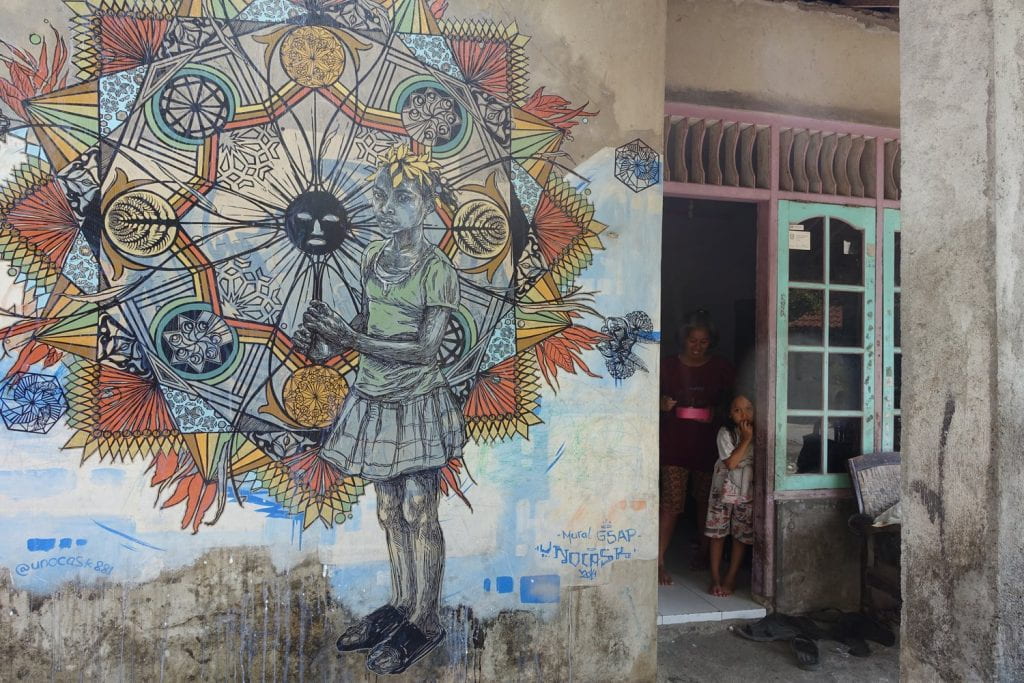
Guest post by Elliot Josephine Leila Reichert.
I first saw the work of Swoon in the summer of 2008. I was in London on a small undergraduate research grant for my thesis. I was writing about the sudden attention being given to an emerging genre called Street Art. This was art that existed mostly outdoors and was unsanctioned either by the local government or the private property owner upon whose structure the work was mounted. Distinct from an earlier era of graffiti, the stylistic approaches to street art were widely varied and less devoted to the importance of “tagging” — that is, repeatedly marking the surfaces of public spaces with a moniker-based design as if in an effort to claim the space as territory. This was no longer the stuff of Style Wars. This was Art with a capital “A.”

This new genre of street art was more akin to unsanctioned public art, as if the contemporary gallery had emptied its contents onto the streets and the paintings had clung onto the only surfaces it could find, on brick walls and bridges. Banksy reigned supreme, but artists like Shepard Fairey and D*Face were still important, and an emerging generation of artists like Eine, Sweettoof, Vhils, and Faile were making significant marks all over London. The East End — still largely working-class and immigrant-populated — was the center of this aesthetic innovation.
While most street artists built highly graphic imagery by spray painting through elaborately hand-cut stencils, one artist stood out for her naturalistic approach to the human form. Caledonia Curry, known by the handle Swoon, used a method called wheatpasting to mount her works to the city walls. As a traditionally trained printmaker, Swoon was adept at transferring her life-size portraits to durable paper and adhering them to surfaces with reversible, nontoxic adhesives. Placing her work in public spaces, her figures seemed to merge with and emerge from the urban fabric like characters in a living fiction.

Swoon was among the very few women in the street art movement, and undoubtedly the most successful of them. Her increasingly elaborate outdoor installations in London, New York, Berlin, Mexico, and elsewhere caught the eye of the influential art dealer and curator Jeffrey Deitch, who brought her work into his gallery and shared it with larger audiences. Invitations to produce museum installations at the New Orleans Museum of Art, Brooklyn Museum, Detroit Institute of Arts, and others came steadily thereafter.

At the Eskenazi Museum of Art, the exhibition Positive Fragmentation: From the Collections of Jordan D. Schnitzer and His Family Foundation presents three artworks by Swoon: Dawn and Gemma (2017), Thalassa (2020), and Yaya (2016). Each was made for the gallery, not the street, but each retains the spirit of Swoon’s street art roots. Thalassa, named after the Greek personification of the sea, depicts a mystical woman emerging from multicolored waves. Silkscreened and handpainted, the entire image clings to the surface of a disused wooden door. Dawn and Gemma, an image of a woman breastfeeding an infant, adheres to a woodframed window pane. These worn-out, distressed architectural surfaces allude to Swoon’s days making work in the streets. Yaya, an image of a man crafting with the wings of butterflies, is pinned to the wall as if it were a wheatpasted work, though it is actually made of fabric and Mylar with blockprinting and acrylic paint.
Swoon’s work has increasingly taken on a mandate of social justice, connecting to issues of forced migration, natural disasters, trauma, and addiction. Through the Heliotrope Foundation, she has organized collaborative projects in Braddock, PA, New Orleans, and Haiti, that center art and creative practices of healing and restorative justice. While her artistic practice grows, she remains close to her street art origins, making art for everyone to enjoy.
Swoon: fearless, a documentary about the artist, will be screened at IU Cinema on December 4 at 1 pm with filmmaker Fredric King scheduled to be present. Before the film, there will be a free gallery talk entitled “Swoon in Focus” at the Eskenazi Museum of Art at 12 pm.

Elliot Josephine Leila Reichert joined the Eskenazi Museum of Art as its first Curator of Contemporary Art in 2019. In addition to conceiving and executing a vision for contemporary art at the museum and cultivating its collection, Reichert serves as an advisor on public art at IU and has been published by platforms like the Brooklyn Rail and the Journal of Visual Culture and served as editor of Northwestern Art Review, the exhibition catalogue The Left Front: Radical Art in the “Red Decade,” and Newcity.